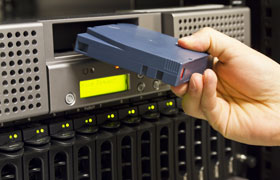
In today’s scenario, so much content is being produced that handling it is the biggest challenge every company is facing. It won’t be wrong to say that every moment becomes a data for further reference from time to time. And where there is data, there is a need for its storage and preservation. The importance is one notch higher in broadcasting and media industry. There is already an ocean of heritage content to be taken care of and the volume is only increasing day by day. Innovators, over a period of time, have come up with various technologies to manage and optimize content to its best possible condition.
It all started in late 1990’s when technology providers Hewlett Packard, IBM Corporation and Quantum Corporation developed and finally introduced the first generation of Linear Tape-Open (LTO), a magnetic tape storage technology in the year 2000 which could hold 100 GB of data in a cartridge. The standard form factor of LTO technology is known by the name Ultrium which is highly scalable and adaptable on multi-platforms like MAC, Linux, and Windows.
LTO has proved revolutionary in terms of data storage with its outstanding performance, capacity, and reliability, combining the advantages of linear multi-channel, data compression, track layout and error correction.
Due to its high success outcome and market demand, regular enhancements have been done and 2017 could see the launch of its 8th generation which can hold data up to 12 TB in a cartridge of the same size. Although, between generations, there are strict compatibility rules clearly defining which drives and cartridges can be used together.
Why Has The Industry Turned To LTO?
The word ‘Tape’ may sound old school but breakthrough enhancement features have made LTO the most suited backup storage medium. Every company needs a storage solution which is high on speed and capacity and has adequate protection levels. Content is available in various forms. LTO Ultrium, being an open format technology provides its users to source data from multiple platforms and store it in a very convenient and easily restored format.
LTO, with each version, have come up with better speed resulting in quick access and recovery. Capacity to store data has increased manifolds. Functionalities like WORM and data encryption provide adequate protection of the valuable data thus by preventing it from getting tampered.
LTO based archiving also proves cost-effective in terms of reduced energy bills and also since storage capacity is ever increasing with each new generation thereby further reducing the cost.
What Does LTO-8 Offer?
LTO-8 was recently revealed in 2017, two years after LTO-7. It is obvious to get attracted to the new improved version but many factors go into this big decision making.If we look at the specifications, LTO-8 offers 12 TB of raw data capacity which is 50% more than what is provided by its previous version. The head channel count also goes up to 32 from 16. The compressed transfer rate has also increased from 750 MB/s to 1180 MB/s. The encryption and WORM feature remains the same.
A new feature which aces up LTO-8 is its ability to increase the cartridge capacity of LTO-7 by 50%. LTO-8 drives can also read and write to LTO-7 tapes thus by saving on the huge investments already made.2
So, before making any decision to consider the switchover, a lot of factors have to be considered in terms of budget, usage, last upgraded time and also to what extent the capabilities of new tapes can be leveraged.
To sum up, we can say that when we think of tapes as a storage and recovery solution, we are focussing on future demands of the ever-increasing volume of data which can be stored and accessed in an environment which is secured as well as cost-effective. And LTO, with its roadmap and growth capabilities, promises to be able to endure Big Data challenges with its continuous breakthroughs.

